Homestead Air Reserve Base
Homestead Air Reserve Base | |
|---|---|
| Part of Air Force Reserve Command (AFRC) | |
| Located near: Homestead, Florida, U.S. | |
 F-16Cs of the 482d Fighter Wing at Homestead ARB, Florida | |
 Homestead ARB Location of Homestead Air Reserve Base, Florida | |
| Coordinates | 25°29′18″N 080°23′01″W / 25.48833°N 80.38361°WCoordinates: 25°29′18″N 080°23′01″W / 25.48833°N 80.38361°W |
| Type | Military base |
| Site information | |
| Owner |
|
| Controlled by |
|
| Site history | |
| Built | 1942 |
| In use | 1942–present |
| Garrison information | |
| Garrison |
|
| Airfield information | |||||||||||
|---|---|---|---|---|---|---|---|---|---|---|---|
| Summary | |||||||||||
| Elevation AMSL | 7 ft / 2 m | ||||||||||
| Website |
www | ||||||||||
| Runways | |||||||||||
| |||||||||||
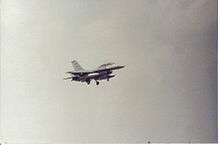
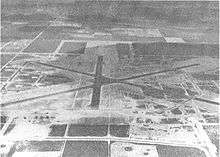
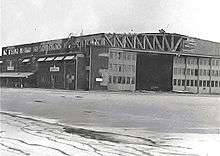
Homestead Air Reserve Base (IATA: HST, ICAO: KHST, FAA LID: HST) (Homestead ARB), previously known as Homestead Air Force Base (Homestead AFB) is located in Miami–Dade County, Florida to the northeast of the city of Homestead. It is home to the 482nd Fighter Wing (482 FW) of the Air Force Reserve Command's Tenth Air Force (10 AF), as well as the headquarters of Special Operations Command South.[1]
Homestead Air Force Base was destroyed by Hurricane Andrew in 1992, and subsequently rebuilt.
History
World War II
The installation was named Homestead Army Air Field on 16 September 1942 as a base for the United States Army Air Forces during World War II, and construction began the next day. Homestead opened as an Air Transport Command (ATC) ferry airfield in November; ATC pilots were trained at the base from February 1943 in the C-46, C-54 and C-87 aircraft. The base was heavily damaged by a hurricane in September 1945, resulting in its inactivation on 14 December 1945.[2] When the U.S. Air Force was established as a separate service on September 18, 1947, the old Homestead AAF lay in ruins.[3]
Cold War
Reactivated for the Cold War as a Strategic Air Command (SAC) installation, an advance arrived at the old base in the summer of 1954 and initiated clean-up and reconstruction efforts. Renamed as Homestead Air Force Base on February 1, 1955. The 379th Bomb Wing was activated at Homestead on November 1, 1955. It replaced the 4276th Air Base Squadron at Homestead in November 1955 and spent the next few months becoming organized and manned. It received B-47 Stratojet and KC-97 Stratotankers in April 1956 and began training for strategic bombardment and air refueling operations. The wing moved to Wurtsmith Air Force Base, Michigan without equipment in January 1961 in preparation for transition to the B-52 Stratofortress and KC-135 Stratotanker.[4]
The 19th Bomb Wing moved to Homestead in April 1956 and also flew the B-47 and KC-97. On July 1, 1961, it was redesignated as the 19th Bomb Wing (Heavy) and began converting to B-52s and KC-135s. The wing moved without personnel or equipment to Robins AFB, Georgia, on July 25, 1968 and absorbed resources of the 465th Bombardment Wing."[5]
In 1962, the 31st Tactical Fighter Wing, a unit of the Tactical Air Command (TAC), relocated to Homestead from George Air Force Base, California with its F-100 Super Sabre jet fighters and established itself as a TAC tenant unit at Homestead, the base remaining under SAC control. With the impending departure of the 19th Bomb Wing, control of Homestead passed from SAC to TAC on July 1, 1968. However, with the 31 TFW deployed to Southeast Asia, the 4531st Tactical Fighter Wing was established as a provisional unit for host wing duties at Homestead pending the return of the 31 TFW in 1970.[6]
Hurricane Andrew
As Hurricane Andrew approached South Florida in late August 1992, the base evacuated their F-16 fighter aircraft to Wright-Patterson Air Force Base near Dayton, Ohio and their Air Force Reserve HC-130 and HH-60 rescue aircraft to Patrick Air Force Base in Cocoa Beach, Florida. Base personnel and their families were under evacuation orders prior to the arrival of the Category 5 storm. The planes and essential personnel stayed in Ohio until April 1993, at which point they were transferred to MacDill Air Force Base near Tampa, Florida.
The stay at MacDill was short lived as the wing returned to Homestead in March 1994. During this time the base was on the Base Realignment and Closure Commission's initial base closings list, potentially dooming the base to closure. However, in the end the base was converted from an active duty base to its present day reserve base status with the 482d Fighter Wing and its F-16 aircraft as the host wing, while concurrently maintaining an 24/7/365 alert detachment of F-15 Eagle fighter aircraft from the Florida Air National Guard's 125th Fighter Wing.[7]
Gallery
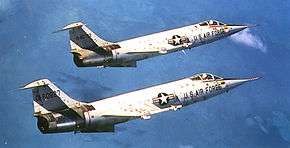 F-104As of the 319th Fighter-Interceptor Squadron over Biscayne Bay, Florida
F-104As of the 319th Fighter-Interceptor Squadron over Biscayne Bay, Florida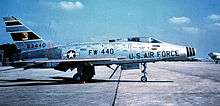 F-100D-85-NH (s/n 56-3440) of the 308th Tactical Fighter Squadron
F-100D-85-NH (s/n 56-3440) of the 308th Tactical Fighter Squadron F-4E-37-MC Phantom II (s/n 68-0365) of the 309th TFS, about 1971
F-4E-37-MC Phantom II (s/n 68-0365) of the 309th TFS, about 1971.jpg) A 307th TFTS F-4D taking off
A 307th TFTS F-4D taking off F-16A Block 15Q (s/n 83-1080) of the 308th FS, about 1988
F-16A Block 15Q (s/n 83-1080) of the 308th FS, about 1988 F-16 Touch-and-Go Landing Practice at Homestead ARB, c. 1996
F-16 Touch-and-Go Landing Practice at Homestead ARB, c. 1996
References
Citations
- ↑ "Units". Homestead Air Reserve Base. Retrieved 26 June 2018.
- ↑ Mueller 1989, pp. 253–255.
- ↑ https://www.homestead.afrc.af.mil/Portals/134/Documents/History%20of%20Homestead%20Air%20Reserve%20Base%20%204%20Apr%202018.pdf?ver=2018-07-26-132208-790
- ↑ http://www.strategic-air-command.com/bases/Homestead_AFB.htm
- ↑ http://www.strategic-air-command.com/bases/Homestead_AFB.htm
- ↑ https://www.homestead.afrc.af.mil/Portals/134/Documents/History%20of%20Homestead%20Air%20Reserve%20Base%20%204%20Apr%202018.pdf?ver=2018-07-26-132208-790
- ↑ Tweten, Ross (August 29, 2012). "Homestead ARB and Hurricane Andrew: A look back, a look forward". Retrieved October 11, 2018.
Bibliography
- Donald, David (2004) Century Jets: USAF Frontline Fighters of the Cold War. AIRtime ISBN 1-880588-68-4
- Martin, Patrick (1994). Tail Code: The Complete History of USAF Tactical Aircraft Tail Code Markings. Schiffer Military Aviation History. ISBN 0-88740-513-4.
- Maurer, Maurer. Air Force Combat Units of World War II. Washington, DC: U.S. Government Printing Office 1961 (republished 1983, Office of Air Force History, ISBN 0-912799-02-1).
- Mueller, Robert (1989). Air Force Bases, Vol. I, Active Air Force Bases Within the United States of America on 17 September 1982 (PDF). Washington, DC: Office of Air Force History. ISBN 0-912799-53-6.
- Ravenstein, Charles A. Air Force Combat Wings Lineage and Honors Histories 1947–1977. Maxwell Air Force Base, Alabama: Office of Air Force History 1984. ISBN 0-912799-12-9.
- Rogers, Brian (2005). United States Air Force Unit Designations Since 1978. Hinkley, England: Midland Publications. ISBN 1-85780-197-0.
External links
| Wikimedia Commons has media related to Homestead Joint Air Reserve Base. |
- Film Footage of Homestead AFB during the Cuban Missile Crisis
- Film Footage of JFK Visiting Homestead AFB
- Homestead Air Force Base at Strategic Air Command.com website
- Article about new Airport Authority in Miami

- USAAS-USAAC-USAAF-USAF Aircraft Serial Numbers-1908 to present
- Joe Baugher's Encyclopedia of Military Aircraft
